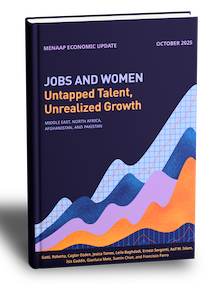Afghanistan | Algeria | Bahrain | Djibouti | Egypt | Iran | Iraq | Jordan | Kuwait | Lebanon | Libya | Morocco | Oman | Pakistan | Palestinian Territories | Qatar | Saudi Arabia | Syria | Tunisia | United Arab Emirates | Yemen
Country Profiles
Chapters
Chapter 1 Macroeconomic outlook
MENAAP growth in 2025 is shaped by divergent trends across sub-regions. Gulf Cooperation Council (GCC) countries are expected to grow by 3.5 percent, benefiting from the phasing-out of voluntary oil production cuts and robust non-oil activity. The outlook has also improved in oil importing countries, where growth is forecast at 3.7 percent driven by private consumption and investment, and a rebound in agriculture and tourism. Conversely, for Developing Oil Exporters, growth is projected to decelerate to 0.5 percent in the wake of conflict-related disruptions and downward adjustments in oil production.
Global trade policy uncertainty may have a modest impact on the region, given current export patterns—though impacts would vary by country. In contrast, oil price swings could significantly affect growth, especially for GCC countries and Developing Oil Exporters. Conflict remains a source of immense suffering in the region—most recently in Gaza—and a major constraint on economic activity, with negative impacts extending to neighboring countries through disruptions to trade and displacement of people. Over 160 million people live in conflict-affected economies of the region; just in 2024, 36 million lived in close proximity to conflict events.
Chapter 2 Untapped Talent, Unrealized Growth: Jobs and Women in the Middle East, North Africa, Afghanistan, and Pakistan
The Middle East, North Africa, Afghanistan, and Pakistan region is at the heart of the global jobs challenge. Working-age population will grow by around 220 million by 2050—close to a 40 percent rise from today and the second largest increase across all regions. At the same time, ongoing demographic shifts, marked by declining fertility and a rapidly aging population, underscore an urgent need to harness untapped human capital. Expanding women’s participation in the workforce, in particular, is the most effective measure to mitigate these challenges.
Across economies in the region, only about 1 in 5 working-age women participate in the labor market – the lowest share in the world. Women’s participation in the workforce is shaped by a complex interaction of restrictive social norms, legal barriers, household decisions, and labor demand forces. Removing these constraints could lift income per capita by 20 to 30 percent in countries like Egypt, Jordan, and Pakistan – among the largest gains in the world. A dynamic private sector that creates jobs, aligns incentives of women to enter the labor markets, helps eliminate discrimination, and transforms aspirations is essential to this process.
The report shows that no region stands to gain more from lifting constraints on women’s labor force participation. Partial fixes won’t suffice: bold, comprehensive, and integrated reforms are needed to break the cycle of low participation and sluggish growth.





